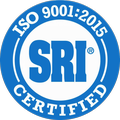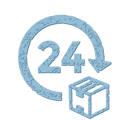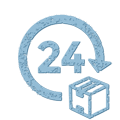ნიობიუმის დამუშავება
All of the normal machining techniques can be used for Niobium. Niobium has a strong tendency to gall. Special attention needs to be paid to tool design and lubricant use. In lathe turning, the metal behaves similar to soft copper. The use of high speed tooling with adequate lubrication and cooling with soluble oil following the parameters given here is recommended.
Although carbide tools can be used, the tendency to gall is more pronounced with them with high speed steel. In turning, the metal should be removed in a shearing action and the chip allowed to slide off the tool surface. When build-up of the chip occurs, the resulting pressure breaks the cutting edge of the tool.
The machining recommendations shown in the accompanying table generally give satisfactory results. The minimum surface speed of 80 feet per minute is important. ნელი სიჩქარე გამოიწვევს ლითონის გახევას, particularly annealed stock. Normally, unannealed metal is preferred for lathe operations.
ბურღვა
Standard high speed drills can be used with good results. The peripheral lands of the drill should be checked often for excessive wear to prevent drilling undersized holes.
სახეხი
როგორც niobium suppliers Eagle Alloys know how difficult grinding is. Most grinding wheels have a tendency to load, and silicon carbide wheels such as Carborundum 120-T (for rough grinding) and 120-R or 150-R (for finishing) should be used. An adequate supply of cooling water is desirable.
Threading
Standard techniques for threading can be used when enough lubricant is available to reduce the galling tendency and consequent tearing of the metal from the surfaces. In threading larger diameters, it is better to cut the threads on a lathe rather than with a threading die. When dies or taps are used, they must be kept free of chips and cleaned often.
Blanking and Punching
Dies and punches made of steels usually used for this purpose are satisfactory for niobium. ა 6% clearance between the punch and the die is recommended. Light oils or similar lubricants should be used to prevent scoring the dies.
ფორმის ჭედურობა
Beryllium copper, aluminum bronzes, and steel may be used for tools. The techniques used can be the same as used for stamping steel. The tools should be polished to reduce the tendency to gall as much as possible. Light oils or similar lubricants should also be used, again to reduce the chances of galling.
ღრმა ნახაზი
Annealed niobium can be deep drawn without too much difficulty. Tool materials recommended for form stamping are also good for drawing operations. Single draws where the depth of the draw does not exceed the diameter of the blank can be accomplished. If more than one draw is to be made, the first draw should not have a depth greater than 40% of the blank diameter. Intermediate annealing in a vacuum may be desirable with multiple draws. Sulfonated tallow and Johnson’s 150 drawing wax can be used as lubricants.
ტრიალებს
Niobium can be spun by conventional techniques using wood formers and steel roller wheels in conjunction with an adequate lubricant such as sulfonated tallow or Johnson’s 150 wax. Spinning is done at room temperature. Beryllium copper or aluminum bronzes are adequate for the tooling. The metal should be worked in small steps or stages with long sweeping strokes using light pressure rather than a few heavy strokes.
შედუღება
As already stated, niobium is a very reactive metal. It reacts with all of the common gases. The metal also reacts with surface contaminants such as oil, grease, residues from degreasing solutions, and residues from cleaning fluids such as acetone. It is for these reasons the surfaces of metal to be welded, either by fusion or resistance welding must be absolutely clean before welding.
An acid etch in a solution of 45 parts nitric acid, 1 part hydroflouric acid, and the rest water at ambient temperatures or up to 65 degrees C (150 გრადუსი F) is acceptable. The amount of hydrofluoric acid may be increased if a more severe etching action is needed. The metal should be thoroughly rinsed after etching, preferably in distilled or deionized water.
Resistance Welding
Resistance welding of niobium to niobium and certain other metals can be done with conventional equipment and techniques. Because of it’s high melting point and relatively low electrical resistance, niobium requires a high power input to obtain a sound weld. Weld duration should be kept as short as possible, preferably 1-10 seconds (60Hz) to prevent excessive heating of the weld area. If at all possible, the work should be flooded with water. In seam resistance welding, the work actually should be submerged in water, to exclude both air from the heat affected zone and to cool the metal as rapidly as possible.
RWMA Class 2 welding electrodes are recommended and should have water cooling. Any copper pick up on the niobium could be easily removed by pickling in nitric acid, which will not attack niobium. As already emphasized, the parts to be welded must be thoroughly cleaned before welding. After the parts have been cleaned, they should be handled with lint-free cotton gloves so that body oils will not contaminate the surfaces.
Fusion Welding
Strong, ductile fusion welds can be made with niobium using TIG welding. Because of the weld’s reactivity with air, certain modifications to the TIG method must be made.
The best approach is to weld in a chamber, using argon or a mixture of argon and helium. If chamber welding is not practical or not available, welding in a normal atmosphere can be done with proper fixturing to provide an inert gas atmosphere not only for the molten zone, but also for the heat affected zone. Trailing shields are necessary to protect the fusion zone during cooling and the metal must not be exposed to air until the temperature has dropped to 260 degrees C (500 გრადუსი F) or lower. The back side of the weld zone must also be protected with inert gas shield during both the welding and cooling cycles.
Normal sheet with a thickness of .050″ or less can be welded without using a filler rod. Heavier sheet often requires the use of filler rod. Bare rod should be used. Use of coated rod or any flux is not good practice, since molten niobium reacts with all of the known fluxes. Cleanliness of the material to be welded as well as the filler rod is essential.






